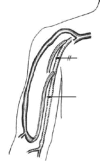Guidelines on vascular access for hemodialysis from the Brazilian Society of Angiology and Vascular Surgery
- PMID: 38021275
- PMCID: PMC10648056
- DOI: 10.1590/1677-5449.202300522
Guidelines on vascular access for hemodialysis from the Brazilian Society of Angiology and Vascular Surgery
Abstract
Chronic kidney disease is a worldwide public health problem, and end-stage renal disease requires dialysis. Most patients requiring renal replacement therapy have to undergo hemodialysis. Therefore, vascular access is extremely important for the dialysis population, directly affecting the quality of life and the morbidity and mortality of this patient population. Since making, managing and salvaging of vascular accesses falls within the purview of the vascular surgeon, developing guideline to help specialists better manage vascular accesses for hemodialysis if of great importance. Thus, the objective of this guideline is to present a set of recommendations to guide decisions involved in the referral, evaluation, choice, surveillance and management of complications of vascular accesses for hemodialysis.
A doença renal crônica é um problema de saúde pública global e em seu estágio terminal está associada à necessidade de terapia dialítica. A grande maioria dos pacientes que necessitam realizar a terapia renal substitutiva, a fazem através da hemodiálise. Portanto, o acesso vascular é de extrema importância para a população dialítica, implicando diretamente na qualidade de vida e na morbimortalidade deste grupo de pacientes. Sendo a confecção, gerenciamento e resgate dos acessos vasculares uma das áreas de atuação do cirurgião vascular, é de grande importância a elaboração de uma diretriz que oriente o especialista no manejo mais adequado do acesso vascular para hemodiálise. Assim, o objetivo desta diretriz é apresentar um conjunto de recomendações para guiar as decisões na referenciação, avaliação, escolha, vigilância e gestão das complicações do acesso vascular para hemodiálise.
Keywords: guideline; kidney dialysis; vascular access.
Copyright© 2023 The authors.
Conflict of interest statement
Conflicts of interest: No conflicts of interest declared concerning the publication of this article.
Figures




















References
Publication types
LinkOut - more resources
Full Text Sources
